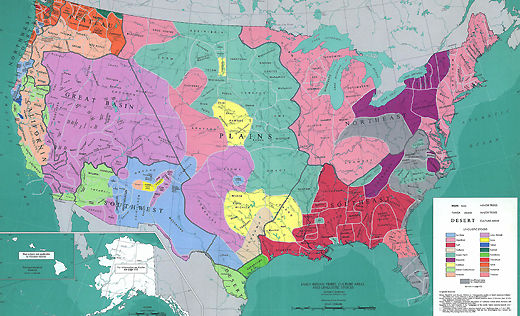
Donald Trump made the news recently by criticizing his fellow Republican presidential candidate Jeb Bush for speaking Spanish at a campaign event.
Trump does not speak any other languages than English, and apparently does not think anyone else should either. He is not the only one who thinks like this. The idea is that people whose first languages are not English are foreigners, speaking foreign languages.
Perhaps he thinks they can’t understand his speeches. I’ve been speaking English all my life and I can’t understand them either.
But consider the following:
In the United States today, approximately 120 to 130 indigenous languages are still spoken by at least a few people. Many of these historic tongues are down to a handful of elderly native speakers (people for whom the language in question was learned since early childhood) each, but others have thousands or tens of thousands of native speakers of all ages.
Navajo has the largest number, estimated at 171,000, followed by Cherokee with perhaps 22,000. Others that have more than 10,000 speakers include Western Apache, Choctaw, Dakota, Keres, Tohono O’Odham and Yupik (of the Inuit-Aleutian language family). Some of these languages have printed publications (the venerable Cherokee Phoenix still publishes some stories in that nation’s distinctive script), and radio stations.
In addition, a number of indigenous languages have more than 1,000 but fewer than 10,000 native speakers in the United States: Mescalero-Chiricahua Apache, Arapaho, Cheyenne, Ojibway, Crow (Apsaalooke), Havasupai-Hualapai-Yavapai, Hawaiian, Hopi, Inupiatun (Inuit-Aleut language family). Jemez (also called Towa), Lakota, Mohawk, Muskogee (Creek), Ottawa, Shoshoni, Tewa, Tiwa, Tsimshian, Yupik (Inuit-Aleut language family) and Zuñi.
And there are efforts in some other Native American communities to revive languages that currently have few or no fluent native speakers.
All told, there are at least 370,000 people in the 50 states who speak these languages, all of which preceded English within what are now the borders of the United States. The vast majority also know English and express themselves in both languages, as the situation requires.
These are not “foreign” languages and could not be more “American.” Yet some years ago I met a woman from a Western European country (which, for the sake of not offending its hard working inhabitants, I will not name) who asked me how long this country’s indigenous language speakers have been here. I replied ” at least 12,000 years, some think much longer, even 40,000 or more.” Her reply: “They’ve been here 40,000 years and they haven’t learned English yet?” That’s the blinkered mentality we have to deal with: Ignorance combined with sheer bigotry.
Mr. Trump was angry, specifically, about public figures speaking Spanish, because he says that English is the language of this country. He regards Spanish as not an “American,” but a “foreign” language. But Spanish was spoken in what is now the United States before English was, because Spanish settlement in the Southwest (and in St. Augustine, Florida) preceded English settlement in Virginia and Massachusetts.
Currently there are about 41,000,000 people in the United States whose first language is Spanish. True, most of these are more recent immigrants and their descendants, but the same could be said of English speakers, who are not all descended from the Mayflower and Jamestown colonists either.
So if Spanish is a foreign language in the United States and hence not “American” so is English.
Furthermore, there are several European language communities in the United States whose presence here precedes U.S. independence: French and several varieties of German. There are people in the 50 states who come from U.S.-controlled territories such as Guam and speak languages from these places.
The United States constitution and federal laws do not specify English as the national language. That is a good thing. To repress someone for use of their ancestral language is an abusive and tyrannical practice.
Older Native Americans tell of a time when, as children, they would be severely punished in school if staff heard them say a single word in an indigenous language. An older Cherokee woman told me that the punishment for her for being caught speaking Cherokee when she was a child was to make her sit in the corner with her nose pressed up against the wall for hours on end. Her experience was not unique or unusual. It was part of a concerted, officially sanctioned effort to wipe out Native American languages.
Do we really want to return to those practices, which have not entirely disappeared in some parts of the country?
Map: Early Localization Native Americans USA by USGS – 1970 USGS map. Licensed under Public Domain via Commons.

MOST POPULAR TODAY

After months of denial, U.S. admits to running Ukraine biolabs

Ohio: Franklin County treasurer attends Netanyahu meeting, steps up Israel Bond purchases

‘Warning! This product supports genocide’: Michigan group aims to educate consumers


“Trail of Tears Walk” commemorates Native Americans’ forced removal






Comments